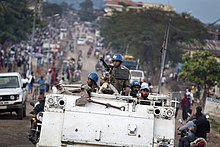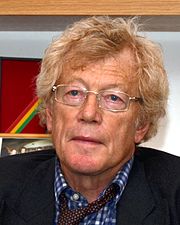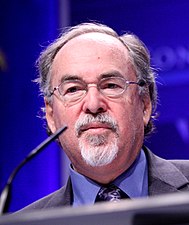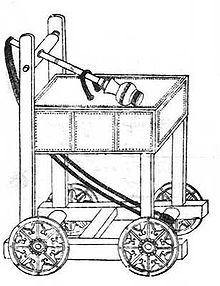Copy of the sculpture Reconciliation, initially presented to the Bradford University Department of Peace Studies, located in front of the Chapel of Reconciliation at the former site of the Berlin Wall
Peace and conflict studies is a social science field that identifies and analyzes violent and nonviolent behaviours as well as the structural mechanisms attending conflicts (including social conflicts), with a view towards understanding those processes which lead to a more desirable human condition. A variation on this, peace studies (irenology), is an interdisciplinary effort aiming at the prevention, de-escalation, and solution of conflicts by peaceful means, thereby seeking "victory" for all parties involved in the conflict. This is in contrast to military studies, which has as its aim on the efficient attainment of victory in conflicts, primarily by violent means to the satisfaction of one or more, but not all, parties involved. Disciplines involved may include philosophy, political science, geography, economics, psychology, sociology, international relations, history, anthropology, religious studies, and gender studies, as well as a variety of others. Relevant sub-disciplines of such fields, such as peace economics, may be regarded as belonging to peace and conflict studies also.
Historical background
Peace and conflict studies is both a pedagogical activity, in which teachers transmit knowledge to students; and a research activity, in which researchers create new knowledge about the sources of conflict. Peace and conflict studies entails understanding the concept of peace which is defined as political condition that ensures justice and social stability through formal and informal institutions, practices, and norms.Addo's con firmamentAs pedagogical activity
Academics and students in the world's oldest universities have long been motivated by an interest in peace. American student interest in what we today think of as peace studies first appeared in the form of campus clubs at United States colleges in the years immediately following the American Civil War. Similar movements appeared in Sweden in the last years of the 19th century, as elsewhere soon after. These were student-originated discussion groups, not formal courses included in college curricula.The First World War was a turning point in Western attitudes to war. At the 1919 Peace of Paris—where the leaders of France, Britain, and the United States, led by Georges Clemenceau, David Lloyd George, and Woodrow Wilson respectively, met to decide the future of Europe—Wilson proposed his famous Fourteen Points for peacemaking. These included breaking up European empires into nation states and the establishment of the League of Nations. These moves, intended to ensure a peaceful future, were the background to a number of developments in the emergence of Peace and Conflict Studies as an academic discipline (but they also, as Keynes presciently pointed out, laid the seeds for future conflict). The founding of the first chair in International Relations at Aberystwyth University, Wales, whose remit was partly to further the cause of peace, occurred in 1919.
Indiana's Manchester College was one of the first institutions to offer a major in peace studies
After World War II, the founding of the UN system provided a further stimulus for more rigorous approaches to peace and conflict studies to emerge. Many university courses in schools of higher learning around the world began to develop which touched upon questions of peace, often in relation to war, during this period. The first undergraduate academic program in peace studies in the United States was developed in 1948 by Gladdys Muir, at Manchester University a liberal arts college located in North Manchester, Indiana. It was not until the late 1960s in the United States that student concerns about the Vietnam War forced ever more universities to offer courses about peace, whether in a designated peace studies course or as a course within a traditional major. Work by academics such as Johan Galtung and John Burton, and debates in fora such as the Journal of Peace Research in the 1960s reflected the growing interest and academic stature of the field. Growth in the number of peace studies programs around the world was to accelerate during the 1980s, as students became more concerned about the prospects of nuclear war. As the Cold War ended, peace and conflict studies courses shifted their focus from international conflict and towards complex issues related to political violence, human security, democratisation, human rights, social justice, welfare, development, and producing sustainable forms of peace. A proliferation of international organisations, agencies and international NGOs, from the UN, Organization for Security and Co-operation in Europe, European Union, and World Bank to International Crisis Group, International Alert, and others, began to draw on such research.
Agendas relating to positive peace in European academic contexts were already widely debated in the 1960s. By the mid-1990s peace studies curricula in the United States had shifted "...from research and teaching about negative peace, the cessation of violence, to positive peace, the conditions that eliminate the causes of violence." As a result, the topics had broadened enormously. By 1994, a review of course offerings in peace studies included topics such as: "north-south relations"; "development, debt, and global poverty"; "the environment, population growth, and resource scarcity"; and "feminist perspectives on peace, militarism, and political violence."
There is now a general consensus on the importance of peace and conflict studies among scholars from a range of disciplines in and around the social sciences, as well as from many influential policymakers around the world. Peace and conflict studies today is widely researched and taught in a large and growing number of institutions and locations. The number of universities offering peace and conflict studies courses is hard to estimate, mostly because courses may be taught out of different departments and have very different names. The International Peace Research Association website gives one of the most authoritative listings available. A 2008 report in the International Herald Tribune mentions over 400 programs of teaching and research in peace and conflict studies, noting in particular those at the United World Colleges, Peace Research Institute Oslo, Universitat Jaume I in Castellón de la Plana/Spain, the Malmö University of Sweden, the American University, University of Bradford, the UN mandated Peace University UPEACE in Ciudad Colón/Costa Rica, George Mason University, Lund, Michigan, Notre Dame, Queensland, Uppsala, Innsbruck/Austria, Virginia, and Wisconsin. The Rotary Foundation and the UN University supports several international academic teaching and research programs.
A 1995 survey found 136 United States colleges with peace studies programs: "Forty-six percent of these are in church related schools, another 32% are in large public universities, 21% are in non-church related private colleges, and 1% are in community colleges. Fifty-five percent of the church related schools that have peace studies programs are Roman Catholic. Other denominations with more than one college or university with a peace studies program are the Quakers, Mennonites, Church of the Brethren, and United Church of Christ. One hundred fifteen of these programs are at the undergraduate level and 21 at the graduate level. Fifteen of these colleges and universities had both undergraduate and graduate programs."
Other notable programs can be found at the University of Manitoba, Lancaster University, Hiroshima University, University of Innsbruck, Universitat Jaume I, University of Sydney, University of Queensland, King's College (London), Sault College, London Metropolitan, Sabanci, Marburg, Sciences Po, Université Paris Dauphine University of Amsterdam, Otago, St Andrews, and York. Perhaps most importantly, such programs and research agendas have now become common in institutions located in conflict, post-conflict, and developing countries and regions such as (e.g., National Peace Council), Centre for Human Rights, University of Sarajevo, Chulalongkorn University, National University of East Timor, University of Kabul,
As research activity
Norwegian academic Johan Galtung is widely regarded as a founder of peace and conflict studies
Although individual thinkers such as Immanuel Kant had long recognised the centrality of peace (see Perpetual Peace), it was not until the 1950s and 1960s that peace studies began to emerge as an academic discipline with its own research tools, a specialized set of concepts, and forums for discussion such as journals and conferences. Beginning in 1959, with the founding of the Peace Research Institute Oslo- PRIO – (associated with Johan Galtung), a number of research institutes began to appear.
In 1963, Walter Isard, the principal founder of Regional science assembled a group of scholars in Malmö, Sweden, for the purpose of establishing the Peace Research Society. The group of initial members included Kenneth Boulding and Anatol Rapoport. In 1973, this group became the Peace Science Society. Peace science was viewed as an interdisciplinary and international effort to develop a special set of concepts, techniques and data to better understand and mitigate conflict. Peace science attempts to use the quantitative techniques developed in economics and political science, especially game theory and econometrics, techniques otherwise seldom used by researchers in peace studies. The Peace Science Society website hosts the second edition of the Correlates of War, one of the most well-known collections of data on international conflict. The society holds an annual conference, attended by scholars from throughout the world, and publishes two scholarly journals: Journal of Conflict Resolution and Conflict Management and Peace Science.
In 1964, the International Peace Research Association was formed at a conference organized by Quakers in Clarens, Switzerland. Among the original executive committee was Johan Galtung. The IPRA holds a biennial conference. Research presented at its conferences and in its publications typically focuses on institutional and historical approaches, seldom employing quantitative techniques. In 2001, the Peace and Justice Studies Association (PJSA) was formed as a result of a merger of two precursor organisations. The PJSA is the North American affiliate of IPRA and includes members from around the world with a predominance from the United States and Canada. The PJSA publishes a regular newsletter (The Peace Chronicle), and holds annual conferences on themes related to the organization's mission "to create a just and peaceful world" through research, scholarship, pedagogy, and activism.
In 2008, Strategic Foresight Group presented its report on an innovative mechanism to find sustainable solution to conflicts in the Middle East. It also developed a new Water Cooperation Quotient, which is a measure of active cooperation by riparian countries in the management of water resources using 10 parameters including legal, political, technical, environmental, economic and institutional aspects.
Description
Peace studies can be classified as:- Multidisciplinary, encompassing elements of Politics and International Relations (particularly critical international relations theory), Sociology, Psychology, Anthropology and Economics. Critical theory is also widely used in peace and conflict studies.
- Multilevel. Peace studies examines intrapersonal peace, peace between individuals, neighbours, ethnic groups, marriages, states and civilisations.
- Multicultural. Gandhi is often cited as a paradigm of Peace Studies. However, true multiculturalism remains an aspiration as most Peace Studies centres are located in the West.
- Both analytic and normative. As a normative discipline, Peace Studies involves value judgements, such as "better" and "bad".
- Both theoretical and applied.
Peace and conflict studies is now well established within the social sciences: it comprises many scholarly journals, college and university departments, peace research institutes, conferences, as well as outside recognition of the utility of peace and conflict studies as a method.
Peace Studies allows one to examine the causes and prevention of war, as well as the nature of violence, including social oppression, discrimination and marginalization. Through peace studies one can also learn peace-making strategies to overcome persecution and transform society to attain a more just and equitable international community.
Feminist scholars have developed a speciality within conflict studies, specifically examining the role of gender in armed conflicts. The importance of considering the role of gender in post-conflict work was recognised by the United Nations Security Council resolution 1325. Examples of feminist scholarship include the work of Carol Cohn and Claire Duncanson.
Ideas
Conceptions of peace
Delegates at the 1953 Korean Armistice Agreement achieved negative peace, ending the war but not the wider conflict
The negative and positive peace framework is the most widely used today. Negative peace refers to the absence of direct violence. Positive peace refers to the absence of indirect and structural violence, and is the concept that most peace and conflict researchers adopt. This is often credited to Galtung but these terms were previously used by Martin Luther King in the Letter from a Birmingham Jail in 1953, in which he wrote about "negative peace which is the absence of tension" and "positive peace which is the presence of justice." These terms were perhaps first used by Jane Addams in 1907 in her book Newer Ideals of Peace.
Several conceptions, models, or modes of peace have been suggested in which peace research might prosper.
- The crux of the matter is that peace is a natural social condition, whereas war is not. The premise is simple for peace researchers: to present enough information so that a rational group of decision makers will seek to avoid war and conflict.
- Second, the view that violence is sinful or unskillful, and that non-violence is skillful or virtuous and should be cultivated. This view is held by a variety of religious traditions worldwide: Quakers, Mennonites and other Peace churches within Christianity; Jains, the Satyagraha tradition in Hinduism, Buddhism, and other portions of Indian religion and philosophy; as well as certain schools of Islam.
- Third is pacifism: the view that peace is a prime force in human behaviour.
- A further approach is that there are multiple modes of peace.
Sustainable peace
Under the conceptions of peace, sustainable peace must be regarded as an important factor for the future of prosperity. Sustainable peace must be the priority of global society where state actors and non-state actors do not only seek for the profits in a near future that might violate the stable state of peace. For a sustainable peace, nurturing, empowerment, and communications are considered to be the crucial factors throughout the world. Firstly, nurturing is necessary to encourage psychological stability and emotional maturity. The significance of social value in adequate nurturing is important for sustainable peace. Secondly, in order to achieve real security, inner security must be secured along with arranged social systems and protection based on firm foundation. Lastly, communications are necessary to overcome ignorance and establish a community based on reliable and useful information. It will prevents isolation to take place which is critical to bring sustainable peace.Conflict triangle
Johan Galtung's conflict triangle works on the assumption that the best way to define peace is to define violence, its opposite. It reflects the normative aim of preventing, managing, limiting and overcoming violence.- Direct (overt) violence, e.g., direct attack, massacre.
- Structural violence. Death by avoidable reasons such as malnutrition. Structural violence is indirect violence caused by an unjust structure and is not to be equated with an act of God.
- Cultural violence. Cultural violence occurs as a result of the cultural assumptions that blind one to direct or structural violence. For example, one may be indifferent toward the homeless, or even consider their expulsion or extermination a good thing.
To simply understand these three
• Direct violence = harming or hurting body & mind • Structural violence= economic exploitation & political repression • Cultural violence = underlying values & epistemic models that legitimize direct & structural violence
Cost of conflict
Cost of conflict is a tool which attempts to calculate the price of conflict to the human race. The idea is to examine this cost, not only in terms of the deaths and casualties and the economic costs borne by the people involved, but also the social, developmental, environmental and strategic costs of conflict. The approach considers direct costs of conflict, for instance human deaths, expenditure, destruction of land and physical infrastructure; as well as indirect costs that impact a society, for instance migration, humiliation, growth of extremism and lack of civil society.Strategic Foresight Group, a think tank in India, has developed a Cost of Conflict Series for countries and regions involved in protracted conflicts. This tool is aimed at assessing past, present and future costs looking at a wide range of parameters.
Normative aims
Peacekeeping efforts by armed forces can provide one means to limit and ultimately resolve conflict
The normative aims of peace studies are conflict transformation and conflict resolution through mechanisms such as peacekeeping, peacebuilding (e.g., tackling disparities in rights, institutions and the distribution of world wealth) and peacemaking (e.g., mediation and conflict resolution). Peacekeeping falls under the aegis of negative peace, whereas efforts toward positive peace involve elements of peace building and peacemaking.
Teaching peace and conflict studies to the military
One of the interesting developments within peace and conflict studies is the number of military personnel undertaking such studies. This poses some challenges, as the military is an institution overtly committed to combat. In the article "Teaching Peace to the Military", published in the journal Peace Review, James Page argues for five principles that ought to undergird this undertaking, namely, respect but do not privilege military experience, teach the just war theory, encourage students to be aware of the tradition and techniques of nonviolence, encourage students to deconstruct and demythologize, and recognize the importance of military virtue.Critical peace and conflict studies: hybridity, trans-rational peace, and elicitive conflict transformation
Scholars working in the areas of peace and conflict studies have made significant contributions to the policies used by non-governmental organisations, development agencies, international financial institutions, and the UN system, in the specific areas of conflict resolution and citizen diplomacy, development, political, social, and economic reform, peacekeeping, mediation, early warning, prevention, peacebuilding, and statebuilding. This represented a shift in interest from conflict management approaches oriented towards a "negative peace" to conflict resolution and peacebuilding approaches aimed at a "positive peace". This emerged rapidly at the end of the Cold War, and was encapsulated in the report of then-UN Secretary-General Boutros Boutros-Ghali, An Agenda for Peace. Indeed, it might be said that much of the machinery of what has been called "liberal peacebuilding" by a number of scholars and "statebuilding" by another is based largely on the work that has been carried out in this area. Many scholars in the area have advocated a more "emancipatory" form of peacebuilding, however, based upon a "Responsibility to Protect" (R2P), human security, local ownership and participation in such processes, especially after the limited success of liberal peacebuilding/ statebuilding in places as diverse as Cambodia, the Balkans, East Timor, Sierra Leone, Liberia, Nepal, Afghanistan, and Iraq. This research agenda is in the process of establishing a more nuanced agenda for peacebuilding which also connects with the original, qualitatively and normatively oriented work that emerged in the peace studies and conflict research schools of the 1960s (e.g. see the Oslo Peace Research Institute research project on "Liberal Peace and the Ethics of Peacebuilding" and the "Liberal Peace Transitions" project at the University of St Andrews) and more critical ideas about peacebuilding that have recently developed in many European and non-western academic and policy circles. Some scholars have pointed towards the hybrid outcomes that have arisen in practice, indicating both the potential and problems of hybrid forms of peace, with an everyday orientation, and suggestive of the emergence of a post-liberal framework.The UNESCO Chair for Peace Studies at the University of Innsbruck/Austria proposed in 2008 a culture-based classification of peace interpretations: energetic, moral, modern, post-modern and trans-rational approaches. The trans-rational approach unites existing spiritual interpretations of society and relation with the mechanistic methods of modern peace. Hence this school prefers the strictly relational and systemic method of elicitive conflict transformation (Lederach) to the prescriptive approaches of modern conflict resolution.
Criticism and controversy
Conservative writers Roger Scruton (left) and David Horowitz (right) are among the critics of peace and conflict studies
A serious number of well established criticisms have been aimed at peace and conflict studies, often but not necessarily from outside the realms of university system, including that peace studies:
- do not produce practical prescriptions for managing or resolving global conflicts because "ideology always trumps objectivity and pragmatism";
- are focused on putting a "respectable face on Western self-loathing";
- are hypocritical because they "tacitly or openly support terrorism as a permissible strategy for the 'disempowered' to redress real or perceived grievances against the powerful" (i.e. ideological anti-Western concepts developed by social scientists such as Johan Galtung which arguably add a sense of unjustified acceptability which is used in support of radicalism)
- have curricula that are (according to human rights activist Caroline Cox and philosopher Roger Scruton) "intellectually incoherent, riddled with bias and unworthy of academic status...";
- have policies proposed to "eliminate the causes of violence" are uniformly leftist policies, and not necessarily policies which would find broad agreement among social scientists.
In the Summer 2007 edition of City Journal, Bruce Bawer sharply criticized Peace Studies. He noted that many Peace Studies programs in American Universities are run by Marxist or far-left Professors. More broadly, he argued that Peace Studies are dominated by the belief that "America ... is the wellspring of the world’s problems" and that while Professors of Peace Studies argue "that terrorist positions deserve respect at the negotiating table," they "seldom tolerate alternative views" and that "(p)eace studies, as a rule, rejects questioning of its own guiding ideology."
Regarding his claim that Peace Studies supports violence in the pursuit of leftist ideology, Bawer cited a quote from Peace and Conflict Studies, a widely used 2002 textbook written by Charles P. Webel and David P. Barash which praised Vladimir Lenin because he “maintained that only revolution—not reform—could undo capitalism’s tendency toward imperialism and thence to war."
David Horowitz has argued that Webel and Barash's book implicitly supports violence for socialist causes, noting that the book states "the case of Cuba indicates that violent revolutions can sometimes result in generally improved living conditions for many people." Horowitz also argued that the book "treats the Soviet Union as a sponsor of peace movements, and the United States as the militaristic, imperialist power that peace movements try to keep in check" and that "the authors justify Communist policies and actions while casting those of America and Western democracies in a negative light." Horowitz also claimed that the authors discuss the Cuban Missile Crisis without mentioning its cause (i.e. the placement of the Soviet missiles in Cuba) and blame John F. Kennedy while praising Soviet Premier Nikita Khrushchev for "be[ing] willing to back down." Finally, Horowitz criticized the author's use of Marxist writers, such as Andre Gunder Frank and Frances Moore Lappe, as the sole basis on which to study "poverty and hunger as causes of human conflict."
Kay and Bawer also specifically criticized Professor Gordon Fellman, the Chairman of Brandeis University's Peace, Conflict, and Coexistence Studies Program, whom they claimed has justified Palestinian suicide-bombings against Israelis as "ways of inflicting revenge on an enemy that seems unable or unwilling to respond to rational pleas for discussion and justice."
Katherine Kersten, who is a senior fellow at the Minneapolis-based conservative think tank Center of the American Experiment, believes that Peace Studies programs are "dominated by people of a certain ideological bent, and [are] thus hard to take seriously." Robert Kennedy, a professor of Catholic studies and management at the University of St. Thomas, criticized his university's Peace Studies Program in an interview with Minneapolis Star Tribune in 2002, stating that the program employs several adjunct professors "whose academic qualifications are not as strong as we would ordinarily look for" and that "The combination of the ideological bite and the maybe less-than-full academic credentials of the faculty would probably raise some questions about how scholarly the program is."
Responses
Such views have been strongly opposed by scholars who claim that these criticisms underestimate the development of detailed interdisciplinary, theoretical, methodological, and empirical research into the causes of violence and dynamics of peace that has occurred via academic and policy networks around the world.In reply to Barbara Kay's article, a group of Peace Studies experts in Canada responded that "Kay's...argument that the field of peace studies endorses terrorism is nonsense" and that "(d)edicated peace theorists and researchers are distinguished by their commitment to reduce the use of violence whether committed by enemy nations, friendly governments or warlords of any stripe." They also argued that:
...Ms. Kay attempts to portray advocates for peace as naive and idealistic, but the data shows that the large majority of armed conflicts in recent decades have been ended through negotiations, not military solutions. In the contemporary world, violence is less effective than diplomacy in ending armed conflict. Nothing is 100% effective to reduce tyranny and violence, but domestic and foreign strategy needs to be based on evidence, rather than assumptions and misconceptions from a bygone era."Most academics in the area argue that the accusations that peace studies approaches are not objective, and derived from mainly leftist or inexpert sources, are not practical, support violence rather than reject it, or have not led to policy developments, are clearly incorrect. They note that the development of UN and major donor policies (including the EU, US, and UK, as well as many others including those of Japan, Canada, Norway, etc.) towards and in conflict and post-conflict countries have been heavily influenced by such debates. A range of key policy documents and responses have been developed by these governments in the last decade and more, and in UN (or related) documentation such as "Agenda for Peace", "Agenda for Development", "Agenda for Democratization", the Millennium Development Goals, Responsibility to Protect, and the "High Level Panel Report". They have also been significant for the work of the World Bank, International Development Agencies, and a wide range of Non Governmental Organisations. It has been influential in the work of, among others, the UN, UNDP, UN Peacebuilding Commission, UNHCR, World Bank, EU, Organization for Security and Co-operation in Europe, for national donors including USAID, DFID, CIDA, NORAD, DANIDA, Japan Aid, GTZ, and international NGOs such as International Alert or International Crisis Group, as well as many local NGOs. Major databases have been generated by the work of scholars in these areas.
Finally, peace and conflict studies debates have generally confirmed, not undermined, a broad consensus (western and beyond) on the importance of human security, human rights, development, democracy, and a rule of law (though there is a vibrant debate ongoing about the contextual variations and applications of these frameworks). At the same time, the research field is characterized by a number of challenges including the tension between "the objective of doing critical research and being of practical relevance".














